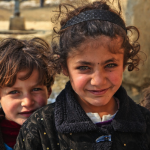Ethnolinguistic Groups of Afghanistan
By Sarah-Claire Jordan
 Afghanistan has always been a country with a huge diversity of ethnolinguistic groups. Much of this may be attributed to the fact that it has long been a bridge between the Middle East and the rest of Asia. This means that many ethnolinguistic groups originally from other areas may have passed through and ended up settling in Afghanistan, adding to the diversity that was already there. Even in the national anthem of Afghanistan, fourteen distinct ethnolinguistic groups are referenced. The highest percentage of the population of Afghanistan belongs to five groups in particular: Pashtun, Tajik, Hazara, Uzbek, and Turkmen.
Afghanistan has always been a country with a huge diversity of ethnolinguistic groups. Much of this may be attributed to the fact that it has long been a bridge between the Middle East and the rest of Asia. This means that many ethnolinguistic groups originally from other areas may have passed through and ended up settling in Afghanistan, adding to the diversity that was already there. Even in the national anthem of Afghanistan, fourteen distinct ethnolinguistic groups are referenced. The highest percentage of the population of Afghanistan belongs to five groups in particular: Pashtun, Tajik, Hazara, Uzbek, and Turkmen.
Pashtun is the largest ethnolinguistic group in Afghanistan, and Pashtun people are often referred to as “ethnic Afghani” people. Those in this ethnolinguistic group originally came from the area of modern Afghanistan and Pakistan sometimes called “Pashtunistan” that is between the Hindu Kush mountains and the Indus River. Pashtun people speak Pashto, which is one of the official languages of Afghanistan. Pashtuns are also the second-largest ethnolinguistic group in Pakistan. The historic origins of the ethnolinguistic group are disputed, but there are many stories dating back to the time of Herodotus and earlier, including the hypothesis that they may be one of the lost tribes of Israel.
Coming in second in terms of how many people make up the ethnolinguistic group is the Tajik ethnolinguistic group. They speak a variety of Eastern Persian, or Dari, as it is called in Afghanistan. Again, there are all kinds of ideas about where the Tajik people originally came from, but they are descendants of Persian-speakers from areas of what is now modern Tajikistan. In Tajikistan, Tajiks are the largest ethnolinguistic group, whereas in Afghanistan they are rivals with Pashtuns in terms of which ethnolinguistic group gets political control over the country.
Hazara are the third-largest ethnolinguistic group in Afghanistan, and one of the most interesting. They speak Persian or Dari, specifically the Hazaragi dialect. The name “hazara” is thought to be a reference to a type of unit in Genghis Khan’s army, which relates to the hypothesis that they are descendants of these soldiers. The dialect of Dari they speak is sprinkled with Mongolian words, and many Hazara display distinct physical traits that are also displayed in ethnic Mongolians. Most Hazara are Shia muslims, which sets them apart from the rest of the Afghan population, who are overwhelmingly Sunni.
The last two groups, Uzbek and Turkmen, are two of the largest Turkic groups in Afghanistan. Uzbeks come from the northern area of Afghanistan, and migrated there as invaders actually, who later mixed their bloodlines with the Iranian tribes in the area. They speak Uzbek, a Turkic language, and are Sunni muslims. The Turkmens are similar, but are nomadic and speak Turkmen, another Turkic language. Uzbeks are the majority ethnolinguistic group in Uzbekistan, and Turkmens in Turkmenistan. The number of Turkmens is much smaller than those of the Uzbeks, but they are both important groups in Afghanistan.
Category: Foreign Language








